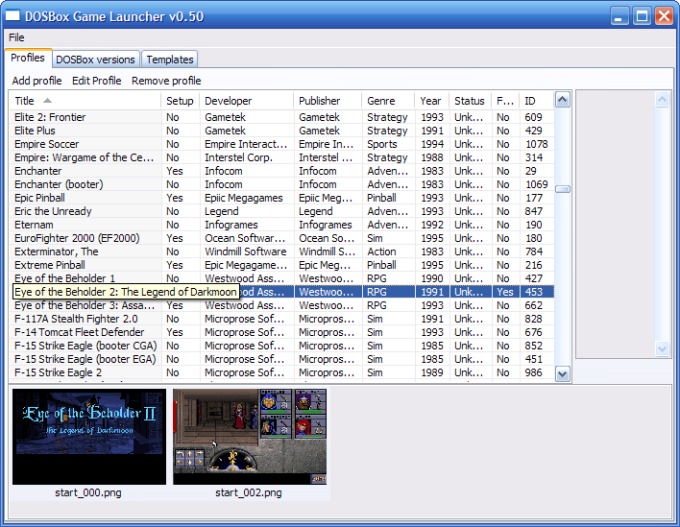

- #DOSBOX DOS EMULATOR .EXE#
- #DOSBOX DOS EMULATOR CODE#
- #DOSBOX DOS EMULATOR WINDOWS 7#
- #DOSBOX DOS EMULATOR PSP#
But I am sure there will be Windows 7 emulators running somewhere in the cloud or on your watch-sized mobile phone. If this is true, Windows 7 will soon be a very primitive OS. Considering that the development in IT is growing exponentially, it is likely that the next five years or so, will bring comparable innovations to those of the last 20 years. The DOS era ended only about 20 years ago, but this environment seems unbelievably primitive compared to today's information technology. When I installed WordPerfect, I began to remember how system administration was in those days. I must say I was quite fascinated when I played with DOSBox. There are a couple of frontends that simplify the configuration. To configure settings, such as the screen size or the amount of high memory available to programs (how I miss these good old DOS times), you have to edit the nf file. COM loads into memory with an offset 0x100H (256 bytes) immediately after PSP (Program Segment Prefix) that is a data structure used in DOS systems to store the state of a program.To run external programs in DOSBox, you have to mount a folder on the host with the command "mount c c:\".
#DOSBOX DOS EMULATOR CODE#
Using debug.exe will actually print the machine-assembly code line by line. It is noted that string should be ended with the dollar sign $ otherwise it will print a mess of craps after the text until reaching one. The first line is to fetch the address of the string ( msg is the label). Be aware that it is a psudo-code and will be eventually converted slightly. The following simply illustrates the process. We use INT 20H to return to DOS (terminate the program). We use INT 21H to call the interrupt (similar as calling sub-procedure). It’s the de facto standard for running DOS games on modern hardware. This environment is complete enough to run many classic MS-DOS games completely unmodified.

We can use the interrupt 09H to print a message, the input string address is specified by DX register. From their site to explain it best: DOSBox is an emulator that recreates a MS-DOS compatible environment (complete with Sound, Input, Graphics and even basic networking). All data and code share the same memory space. COM file will be loaded and instructions will be fetched from the beginning (offset = 0). It has a different settings file, mounting doesnt 100 work properly (i.e., getting entire downloads instead of right folder), and it simply wont run Doom. COM file executable is a 16-bit binary code that is at most size of 65,280 (FF00h) bytes (256 bytes short of 64 KiB). I normally like DosBox, and use it for all my dos emulation on my PC, but this is simply a bad port.
#DOSBOX DOS EMULATOR .EXE#
EXE (similar to what we have on Windows nowadays e.g.
#DOSBOX DOS EMULATOR PSP#
COM (binary executable, tiny address space, contains code no larger than 64KB less 256 bytes for PSP Program Segment Prefix, all data and code are together in the same space), and. BAT (is a plain text file that lists the commands to execute line by line). In DOS era, there are three kinds of executables. The above shows you a useful command that is mount, which can be used to mount a specific directory (your windows system) to a virtual drive (in your DOSBOX emulator).Īnd it is possible to mount with the CD-ROMs.Īnd also, it is provided with some special keys that can speed up things. If you type intro that will give you some commonly-used preparation commands to aid you using DOS emulator. Upon completion of installation, we’ll have a welcome window:įollowed by the Shell prompt (at the start, it is Z:\ which contains some core files of DOS, such as (core kernel), autoexec.bat (batch file that runs automatically when shell is loaded). So you can run your DOS programs without problems in this emulator. Luckily, there is an opensource project ongoing, The DOSBOX ( ) is an x86 emulator with DOS. The debug.exe is considered the most powerful tool under 16-bit DOS at that era. This is understandable, but for the programmers like me, I have a very nice memory old times programming DOS programs such as Assembly, playing around 16-bit registers, AX, BX, CX and DX. If you run 16-bit DOS programs, you will have something popped up like below, on Win8 (64-bit): However, at Win7 and Win8, 16-bit DOS programs are abandoned completely, in order to improve the system stability. However, in order to run DOS programs, the DOS console (command shell) is introduced, which is a 32-bit emulator that runs 16-bit DOS program but at the meantime supports 32-bit programs as well. From Win2000 (maybe WinNT), the OS completely rewrites the kernel and abandons DOS. Actually, the GUI of Windows at that time is a program that runs above the DOS shell. Thus, the OS runs at a mixed mode of 16 and 32 bit, which yields problems sometimes that are caused by 16-bit programs. and if you type anything incorrect, it will complain this by outputting a message: Bad Command or Filename.Īt Win9x, (win95 and win98) the DOS kernel (16-bit) is kept for backward compatibility.

The DOS is an shell-like system that is famous for its prompt C:\.

The Microsoft DOS (Disk Operating System) has been very popular once (1980s and early 90s) but now it has now completely reached its end.


 0 kommentar(er)
0 kommentar(er)
